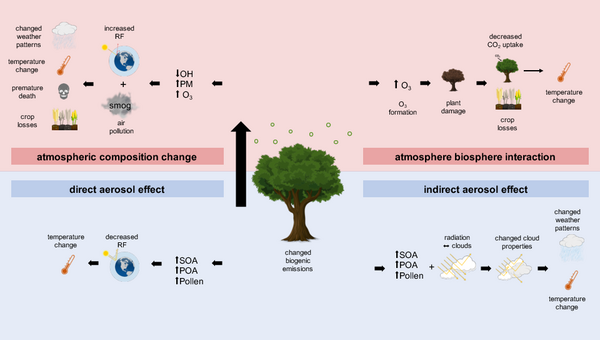
Fig. 1: Schematic diagram of the feedback between biosphere and atmosphere, as well as the link between air quality and climate (red background associated with worming and blue background with cooling effect).

Biogenic Aerosols (BA) comprise aerosols directly released from the biosphere into the atmosphere (PBA: algae, bacteria, fungal spores, plant debris, ...), as well as secondary origins (secondary organic Aerosol SOA) formed from biogenic volatile organic compounds (BVOCs), which are SOA precursors. BA have a size range from nanometers to 0.1 mm.
Pollen
Airborne pollen grains are a part of PBA which are well mixed and interact with other aerosols and or other components of the air including photo-oxidants and pollutants (acids, NOx, etc.). The emission, dispersion and concentration of pollen is controlled by plant specific (total amount of pollen, seasonality…) and meteorological quantities (temperature, relative humidity, precipitation, wind velocity and direction, radiation, mixing layer height…). During transportation additional processes effect the PBA (stress, physical conversion, UV radiation, cloud processes, wet and dry deposition). Due to aging processes or under humid conditions the pollen ruptures and releases sub-pollen particles (SPP) and allergic proteins. Under certain meteorological conditions (thunderstorms) life-threatening allergic conditions can be reached. SPPs are efficient cloud condensation nuclei (CCN) and ice nucleating particles. CCNs and INPs effect the reflectivity (albedo), evolution and lifetime of clouds as well as precipitation. Climate change will affect pollen diversity and distribution directly by changed meteorological conditions and indirect by entailed land-use changes.
BVOCs and SOA
Plants release a variety of BVOCs like isoprene, monoterpenes, sesquiterpenes and other oxygenated compounds (OVOCs). Whereby, the emission strengths and compositions of BVOCS are plant species specific leading to quite distinct emissions among different plants. Trees are the strongest BVOC emitters. BVOC emission is mainly controlled by temperature and solar radiation. But curtain stressors (injuries, herbivores, ozone, UV-radiation, drought, heat) can impact BVOC emission strength as well as composition. The stress response itself is plant species specific, too. BVOCs are highly reactive and get quickly oxidised by ozone, OH and NO3 radicals. The chemical degradation of VOCs under high NOx conditions leads to ground level ozone formation. Furthermore, progressing oxidation of the BVOCs lowers their volatility, enabling particle phase transition and producing SOA. Which can lead to new particle formation or particle growth, if low volatility compounds condense onto existing particles. Both processes are essential for CCN formation. BVOC impact air quality (NOx, ozone, SOA as part of PM) as well the climate (ozone, oxidant concentrations, radiation, cloud, precipitation).

Fig. 1: Schematic diagram of the feedback between biosphere and atmosphere, as well as the link between air quality and climate (red background associated with worming and blue background with cooling effect).
Unfortunately BVOC emission estimates bear huge uncertainties, which are mainly due to model input parameters (meteorological driver, land use and related parameters). Global values for isoprene emission range from 350 to 800 Tg yr-1 and for the SOA budget from 12 to 1820 Tg yr-1. By now, tree planting programs are a common key feature for climate change adaptation and mitigation strategies. But as BVOC emission strength and composition is tree species specific such programs might further impair air quality and in the long-term the climate. In order to consider all climate and air quality relevant aspects, more knowledge of plant species specific impacts is of utterly importance.